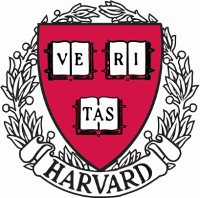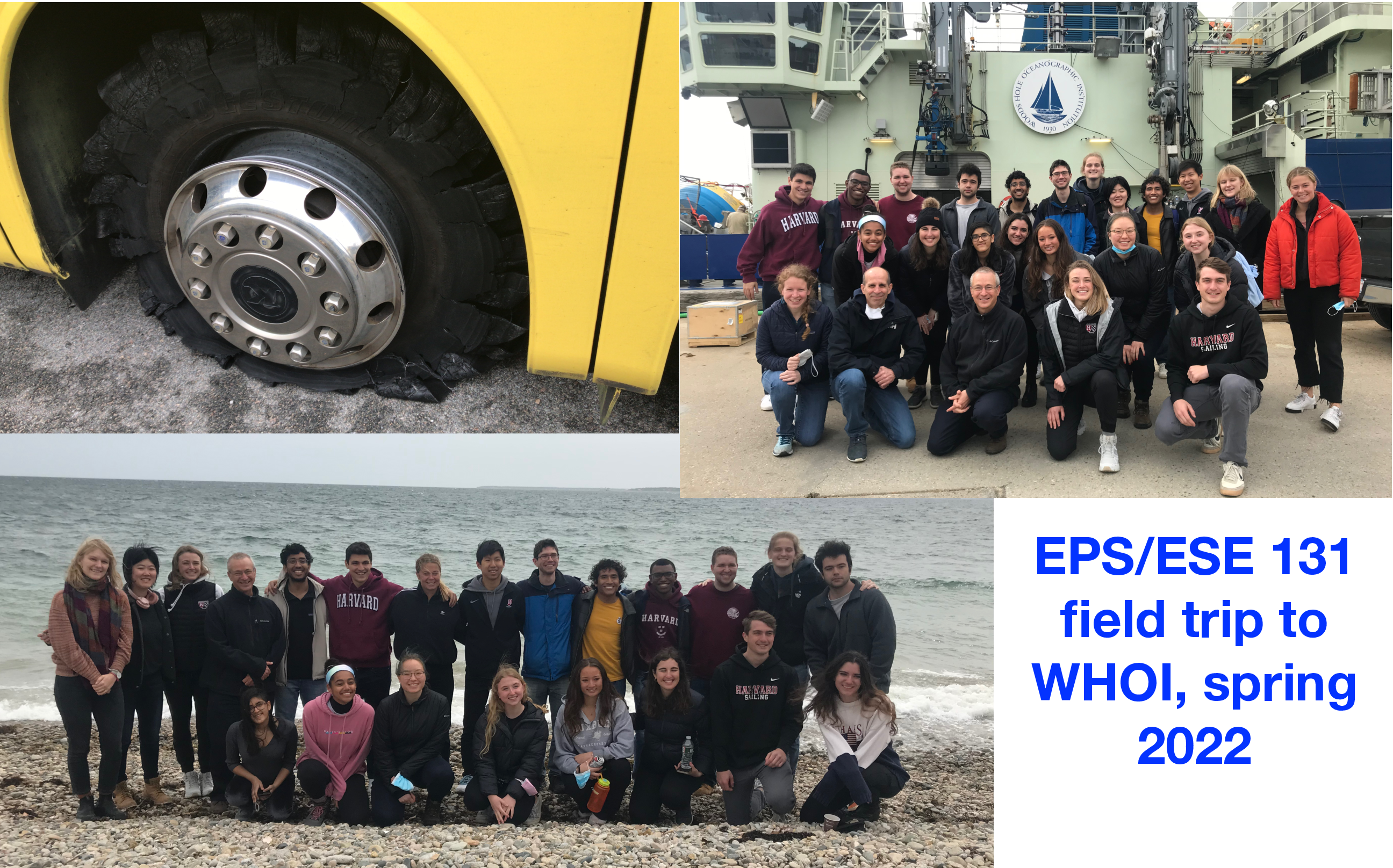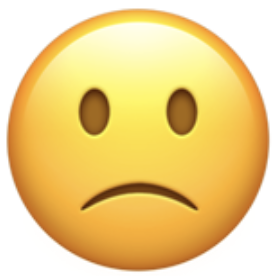
EPS/ESE 131: Introduction to Physical Oceanography
and Climate
Spring 2022
Canvas course web page for EPS/ESE 131
Last updated: Monday 26th September, 2022, 20:37.

EPS/ESE 131: Introduction to Physical Oceanography
and Climate
Spring 2022
Canvas course web page for EPS/ESE 131
Last updated: Monday 26th September, 2022, 20:37.

Field trip to the Woods Hole Oceanographic Institution, spring 2022.
This is:
Earth and Planetary Sciences/ Environmental Science and Engineering 131: Introduction to Physical Oceanography and Climate.
Instructor:
Eli Tziperman, office hours: please see Canvas course web page.
TF:
Camille Hankel, Camille_Hankel@g.harvard.edu. Office Hours: Canvas course webpage.
Day, time & location:
Tuesday, Thursday, 10:30–11:45, Geological Museum, 24 Oxford St, third floor, room 375.
Field Trip!
To the Woods Hole Oceanographic Institution/ WHOI, obligatory & fun; hosted by Dr. Bob Pickart; Thursday, April 7, 2022. Departing at 7:00 am, returning around 6 pm.
Section/HW help session:
time and location: see Canvas course web page.
Sources directory:
with all class notes, demos, code, data! here, or DropBox link from Canvas page.
Important past events…:
WHOI field trip. In previous trips we visited the R/V Atlantis, R/V Knorr, R/V
Armstrong, the submersible Alvin, and we toured WHOI labs. Photos: 2005, 2008,
2010, 2012, 2014, 2016, 2018, 2020 no trip, Covid  , 2022.
, 2022.
EPS 131 Oscars (video project) events: 2005: surface waves; 2008: internal waves; 2010: great Pacific garbage patch; 2012: thermohaline circulation; 2014: surface waves; 2016: brine rejection; 2018: phase speed in 2d; 2020: sweet viscosity; 2022: sea level;
zeta vs xi (ζ vs ξ) competition: 2008, 2010, 2012, 2014, 2016, 2018, 2020, 2022.
The real stuff: Three 2022 EPS131 veterans on a cruise with Bob Pickart on the R/V Norseman II to the northern Bering/Chukchi/western Beaufort Seas!
Requirements:
Homework will be assigned every 9–10 days (40% of course grade, lowest HW grade dropped). Each student will give one to two short (10 min) presentation(s) (details), which, together with a small-group video project (examples above) and/or a Wikipedia entry-writing project, will constitute another 30%. The final exam will be an open-book take-home (30%).
Course forum:
Please post questions regarding HW or other issues to the course forum (piazza.com/harvard/spring2022/epsci131). You are very welcome to respond to other students’ questions.
Electronic homework submission:
Your submission, via www.gradescope.com/courses/279832, may be typeset or scanned, but must be clear, easily legible, and correctly rotated. A scan using a phone app (e.g., this) may be acceptable if done carefully. Upload different files for the different questions, or upload a single pdf and mark which pages contain answers to which question; see tutorial video. Unacceptable scans could lead to a rejection of the submission or to a grade reduction of 15%.
Recommended Prep:
Mathematics 21a, 21b; Physical Sciences 12a, Physics 15a or Applied Physics 50a; or equivalents/ permission of instructor. Basic programming for scientific computation and graphics will be introduced (students may choose either Matlab or python) and will be used for some homework assignments, no prior programming experience is assumed.
Academic Integrity and Collaboration policy.
We strongly encourage you to discuss and work on homework problems with other students and the teaching staff. However, after discussions with peers, you need to work through the problems yourself and ensure that any answers you submit for evaluation are the result of your own efforts, reflect your own understanding, and are written in your own words. In the case of assignments requiring programming, you need to write and use your own code; code sharing is not allowed. You must appropriately cite any books, articles, websites, lectures, etc. that have helped you with your work.
Course materials are the property of the instructional staff or other copyright holders, and are provided for your personal use. You may not distribute them or post them on websites without the permission of the course instructor.
Observations and fundamentals of ocean dynamics, from the role of the oceans in global climate and climate change to beach waves. Topics include the greenhouse effect, oceans, and global warming; El Niņo events in the equatorial Pacific Ocean; currents: the wind-driven ocean circulation and the Gulf stream; coastal upwelling and fisheries; temperature, salinity, the overturning circulation, and its effect on global climate stability and variability; wave motions: surface ocean waves, internal waves, tsunamis, and tides; ocean observations by ships, satellites, moorings, floats and more.
A field trip to the Woods Hole Oceanographic Institution on Cape Cod will be held during the course, which will be an opportunity to learn about sea-going oceanography. Basic programming will be introduced in sections (students may choose either Matlab or python) and for some homework assignments.
Here is a link to the pdf of the detailed syllabus, and to the directory with all source materials and lecture notes.
Outline and motivation, downloads.
Temperature and salinity, downloads.
Horizontal circulation I: currents, Coriolis force, downloads.
Waves, downloads.
Sea-going physical oceanography
Finally, the real stuff. Two lectures by Dr. Bob Pickart from the Woods Hole Oceanographic Institution, and a field trip to Woods Hole.
Friction, Ekman, downloads.
The meridional overturning circulation, downloads.
Horizontal circulation II: vorticity, Gulf Stream and other western boundary currents, Rossby waves, abyssal circulation, downloads.
El Nino, downloads.
(Time permitting) Abrupt climate change, downloads.
Assignments are available here; please email if you are teaching a similar course and are interested in the solutions.
Beginning texts:
John A. Knauss, Introduction to Physical Oceanography, 320 pages (2nd edition), 2005.
J. Marshall and R. A. Plumb, Atmosphere, ocean, and climate dynamics, 319pp, 2008.
Lynne D. Talley, George L. Pickard, William J. Emery, and James H. Swift, Descriptive Physical Oceanography — An Introduction (6th edition), online, 2011.
Stephen Pond and George L. Pickard, Introductory dynamical Oceanography (3rd edition), 1993.
Evelyn Brown, Angela Colling, Dave Park, John Phillips, Dave Rothery, and John Wright, Open university: Ocean Circulation (2nd Edition), 2001.
Wright, John, Angela Colling, and Dave Park, Open university: Waves, Tides, and Shallow-Water Processes (2nd Edition), 1999.
Robert H. Stewart, Physical Oceanography, online, 2008.
Matthias Tomczak and J. Stuart Godfrey, Regional oceanography, online, 1994.
Eli Tziperman, Global Warming Science: A Quantitative Introduction to Climate Change and Its Consequences, details, 2022.
Intermediate texts:
Philander, S. G. H., El Niņo, La Niņa, and the Southern Oscillation, 1990.
Kundo P.K. and Cohen I.M., Fluid mechanics (2nd edition) 2002.
Advanced texts:
Vallis, G., Atmospheric and oceanic fluid dynamics, fundamentals and large-scale circulation (2nd edition), 2017.
Pedlosky, J., Geophysical Fluid Dynamics (2nd edition), 1987.
Pedlosky, J., Ocean circulation theory, 1996.
Pedlosky, J., Waves in the ocean and atmosphere, 2003.
Gill, A. E, Atmosphere-ocean dynamics, 1982.
Greenpeace bottom trawling and protect the oceans.
Shifting baselines: “pristine”.
NOVA documentary about the Sumatra Tsunami of 2004, with more here.
Ocean acidification NRDC video
Orca hunting video
Ocean data sources: Marine Explorer, Ocean Data Viewer, and the IRI/LDEO Climate Data Library.